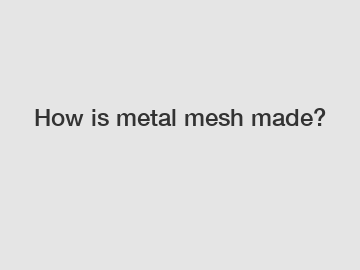How is metal mesh made?
How is Metal Mesh Made?
Metal mesh is a versatile and widely used material in various industries, including construction, filtration, and automotive. It is commonly used for its strength, durability, and high heat resistance. But have you ever wondered how metal mesh is actually made? In this article, we will take a closer look at the manufacturing process of metal mesh.
Wire Drawing: The First Step.

The first step in making metal mesh is wire drawing. This process involves pulling a metal rod or wire through a series of dies, which gradually reduce its diameter. Wire drawing is performed to achieve the desired thickness and uniformity of the wire. It also helps in improving the mechanical properties of the wire, such as tensile strength and ductility.
Annealing: Enhancing the Wire's Properties.
After wire drawing, the wire is usually annealed to enhance its properties. Annealing involves heating the wire to a specific temperature and then slowly cooling it. This process helps to relieve any internal stresses and improve the wire's ductility. Additionally, annealing improves the wire's machinability and allows it to be easily formed into different shapes during the mesh manufacturing process.
Weaving: Creating the Mesh Pattern.
The next step in making metal mesh is weaving. Weaving is the process of interlacing wires together to create a pattern. There are various weaving techniques used, such as plain weave, twill weave, and Dutch weave, depending on the desired mesh characteristics. Weaving can be done manually or with the help of specialized machines. The weaving process determines the final appearance, open area, and mechanical properties of the mesh.
Cutting and Edging: Giving Shape to the Mesh.
Once weaving is complete, the metal mesh is usually in the form of a continuous sheet. It needs to be cut into desired shapes and sizes. Cutting can be done using various methods, including shearing, laser cutting, or stamping. The edges of the mesh may also be finished for safety and cosmetic purposes, often by rolling the wire edges or adding edge reinforcements.
Surface Treatment: Enhancing Durability and Appearance.
To enhance the durability and appearance of metal mesh, surface treatment is often applied. Surface treatment can include processes such as galvanizing, powder coating, or painting. These treatments provide added protection against corrosion, wear, and weathering. They also allow the mesh to be customized with different colors and finishes, depending on the application requirements.
Quality Assurance: Ensuring Consistency and Performance.
Throughout the entire manufacturing process, quality assurance is crucial to ensure that the metal mesh meets the required specifications and standards. Stringent quality control measures are implemented to check the wire diameter, mesh size, and mechanical properties. Testing may also be conducted to evaluate the mesh's performance in terms of tensile strength, elongation, and resistance to environmental factors.
Conclusion:
Metal mesh is made through a series of intricate processes, including wire drawing, annealing, weaving, cutting, surface treatment, and quality assurance. Each step plays a crucial role in determining the final characteristics of the mesh, such as strength, durability, and appearance. Understanding the manufacturing process of metal mesh helps in appreciating its versatility and importance across various industries.
If you have any further questions or would like to learn more about metal mesh, please feel free to contact us. Our team of experts will be happy to assist you.
If you are looking for more details, kindly visit 316 stainless steel perforated sheet, stainless steel wire mesh panels, 2x2 galvanized wire mesh.


